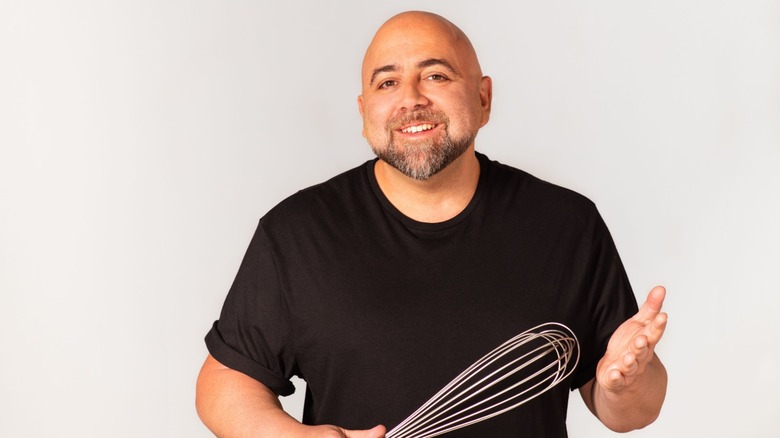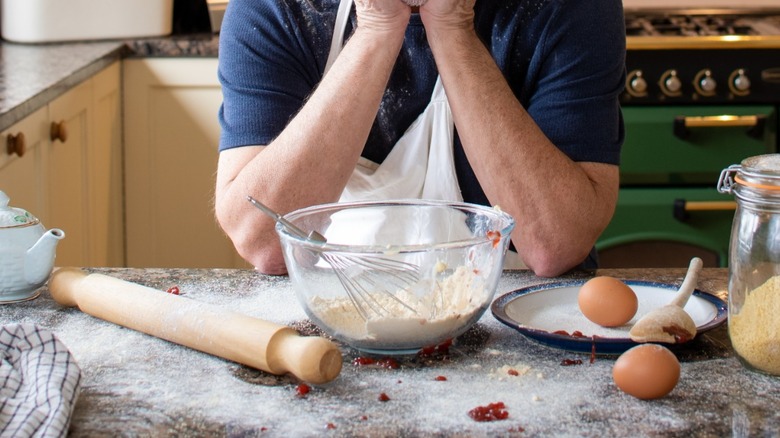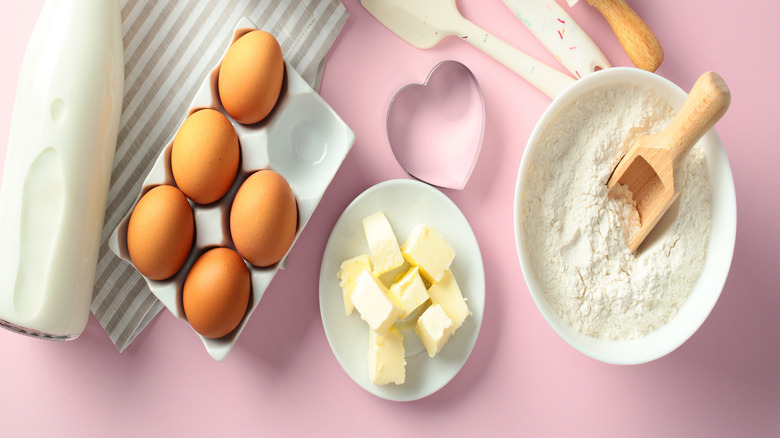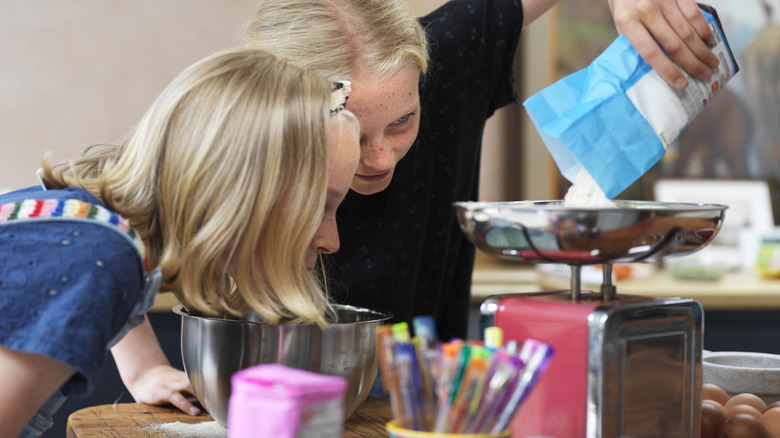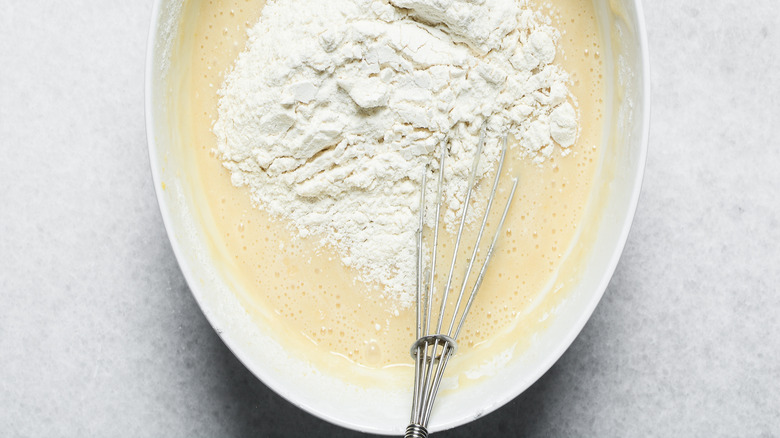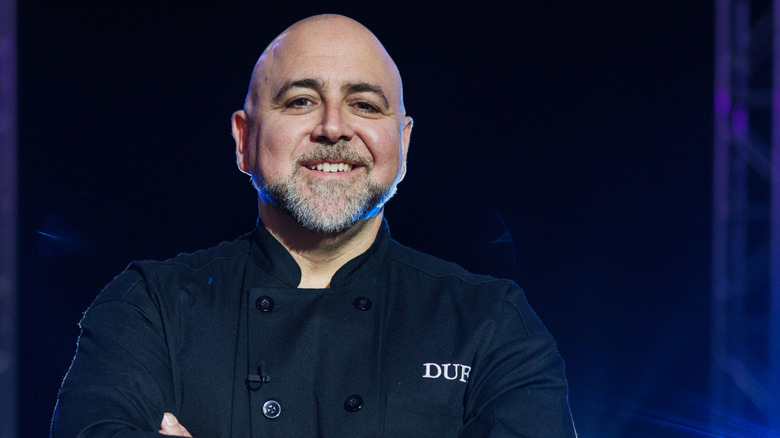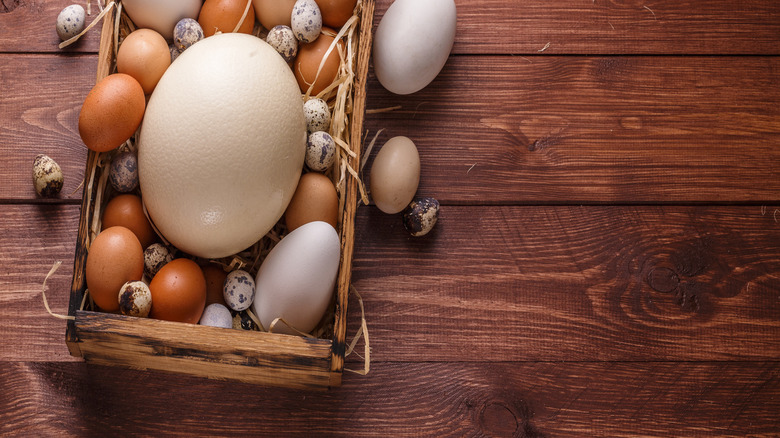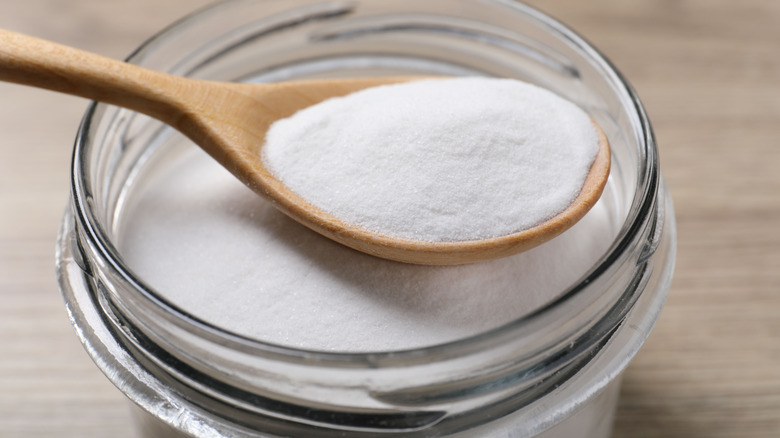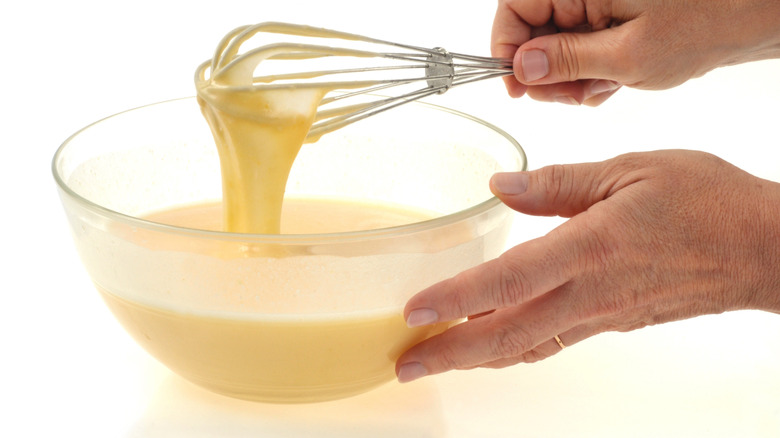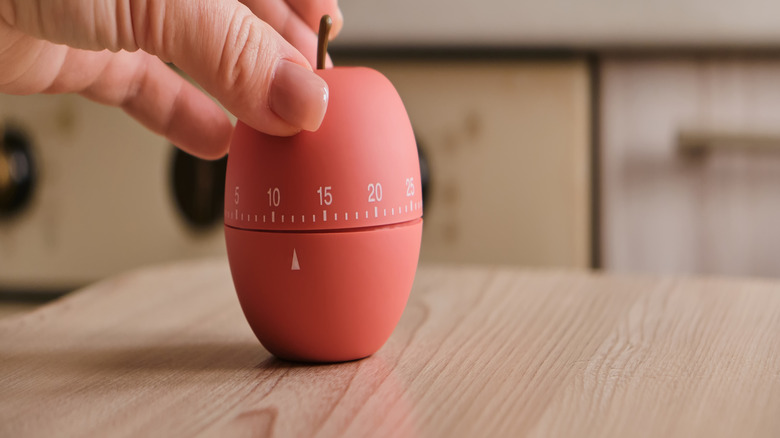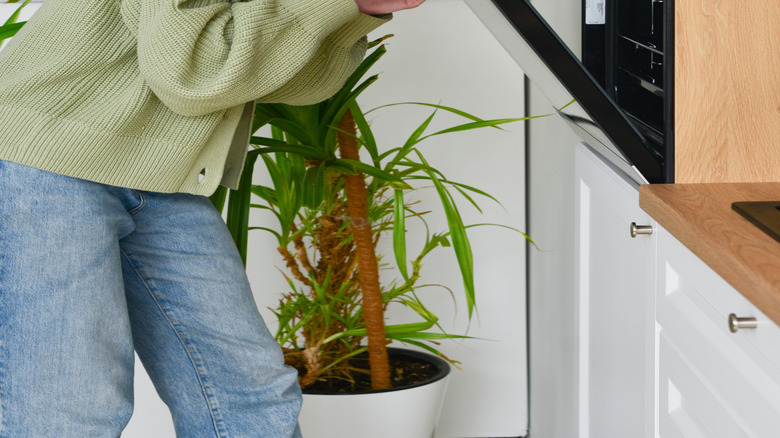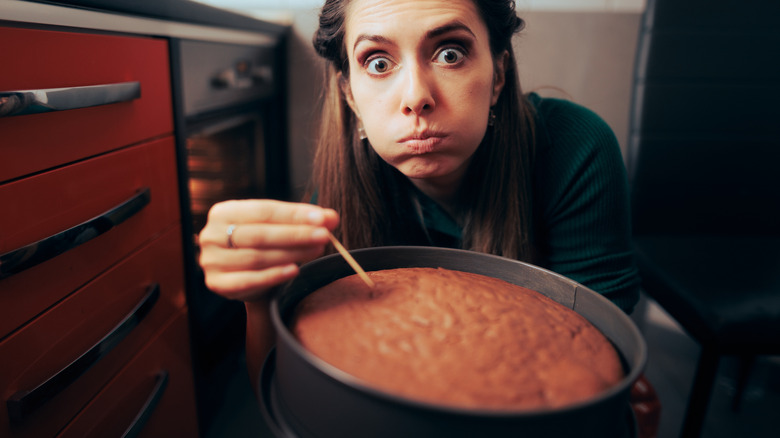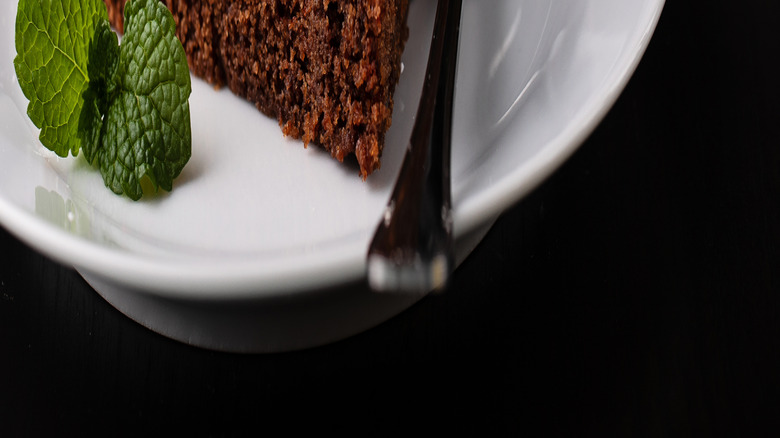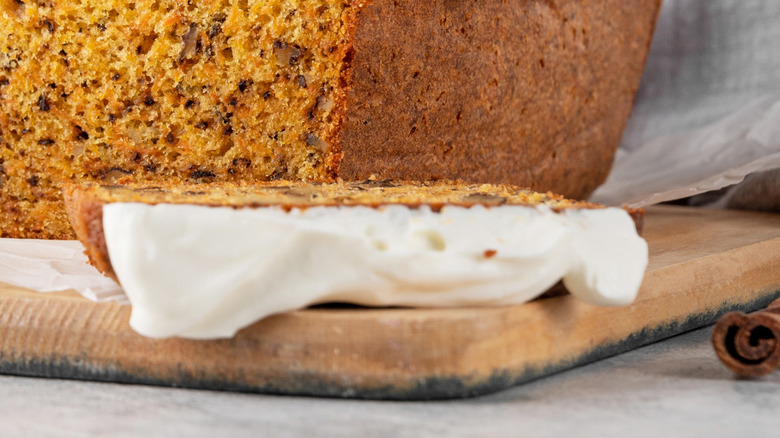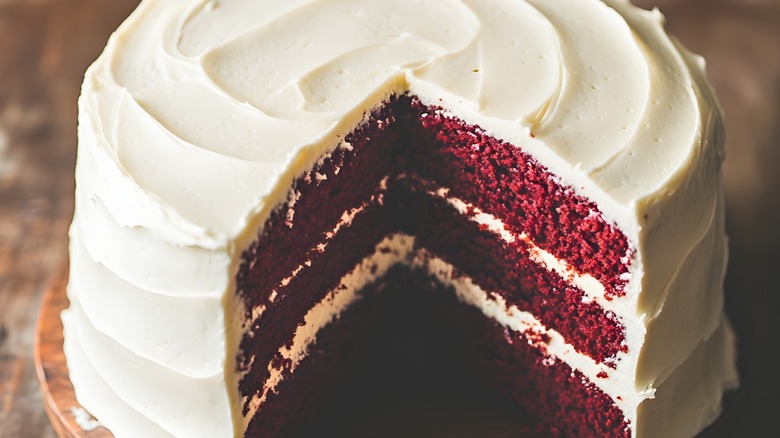Duff Goldman Tells Us His Solutions To Common Cake Making Problems
We may receive a commission on purchases made from links.
Nothing brings people together like cake. From birthday and wedding celebrations to a cheeky afternoon treat, it's the comfort food to beat them all. Whether you're team yellow cake or triple chocolate fudge 'til you die, there is a flavor combination for everyone. For many home bakers, cake is the first thing they learn how to cook, transforming flour, sugar, butter, and eggs into a delicious, feather-light sponge. Or perhaps not.
A recipe that looks so simple in an online tutorial or in a cookbook can lead to disaster after disaster, prompting some people to throw in the towel and order a cake from their local Costco, instead. But all is not lost. Duff Goldman, pastry chef and presenter of T.V.'s "Super Mega Cakes" has stepped up to offer his solutions to common cake making problems. Take some advice from a pro and improve your cake-baking skills for the better.
Always be organized when baking a cake
Every recipe we watch on a T.V. show or online video usually has all the ingredients pre-weighed, where appropriate, and ready to drop into their mixing bowl. While that makes for a smooth cooking segment or smartly edited video, it's a little different for home cooks. You don't necessarily need to do all that preparation in advance (who really has that many glass bowls?) but it does pay to be organized when you're baking a cake.
There are few things more annoying for "Super Mega Cakes" host Duff Goldman than suddenly realizing you've run out of a crucial ingredient. "Once you start, you can't stop and run to the store really quick," he said. That means checking your cupboards thoroughly to make sure you have enough of everything you need to make a cake before you get started.
Ensure all your cake ingredients are at room temperature
Making a cake can feel a little like a science experiment, and if you want the final result to be more of a glowing success than a radioactive meltdown, have all your ingredients, including the butter and eggs, at room temperature before you bake. There are two good reasons for this.
The first, according to Duff Goldman, is that it will make your cake batter much easier to mix. The second is connected to this, and it all has to do with air. If your butter is cold, it's harder to break down and incorporate into the batter, making it trickier to beat in the air needed for your cake to rise.
Because you have to beat the ingredients for longer, it often leads to over-mixing which is bad news for your cake's texture. Likewise, cracking multiple eggs that have been sitting in your fridge into the mix will have the same impact: You'll end up with a dense, tight crumb instead of a soft, light sponge.
Carefully measure all the ingredients for your cake
"Baking is based on ratios and formulas and chemical reactions, and all those things depend on using the proper amounts of all your ingredients," said Duff Goldman. What does that mean in simple terms for home cooks? Measure. Every. Ingredient.
Before you start fluffing your flour, it's a good idea to give your kitchen scales the once-over. If they're digital, are the batteries good? If they're traditional ones with a dial, check they're weighing correctly with a sealed packet of something that has its weight marked on it.
If you need to double or triple a recipe to create more batter, do the math beforehand, so you know exactly how much of everything you need. Finally, when it comes to the actual weighing, baking is all about precision: A few grams here or there really can make the difference between a delicious dessert and a cake catastrophe.
Use the right flour for your cake
Anyone who bakes their own bread will know there is a vast array of flours available, from all purpose and whole wheat, to nut flours, as well as older varieties like spelt and rye. When it comes to baking cakes, however, the range is a little more limited, and it's all because of gluten. While it's a key ingredient in bread, helping it to rise and giving it that delicious, chewy texture we know and love, the protein can have a negative impact on cakes.
That's why specialist cake flour contains less gluten than other kinds, allowing home bakers to turn out fluffy cakes that aren't dense or chewy like bread. That said, when pastry chef Duff Goldman bakes, he mostly relies on all-purpose flour, and only on occasion does he use cake or pastry flour. If it's good enough for the host of "Super Mega Cakes," it's got to be good enough for us mortals.
You can experiment with sugar
The recipe for a basic sponge cake is pretty simple: Use 8 ounces of sugar, flour and butter, mixed with four eggs. It's been that way forever, so why would you want to mess with it? Well, regular bakers know you can play around with those fundamental ingredients and still turn out delicious, successful cakes — including switching out the sugar.
There has been a boom in recent years in products that have all the taste and appearance of sugar, and they're great for more than simply stirring in your coffee. Many can be used in baking, taking the place of white sugar and potentially making a sweet treat slightly better for us.
Duff Goldman recommends playing around to find alternatives that will work. "Most recipes are written for white granulated sugar, so to alter that to something like honey or stevia or anything that isn't white sugar will take a little experimenting," he said.
Weigh your eggs to get the right size
It's easy to make sure you have the right quantities of flour, sugar, and butter in your cake, but when it comes to the eggs, that can be a bit trickier. There can be quite a difference between a medium and a large egg, and getting the amount wrong can be disastrous. Too few and you get a dry cake that can't hold together. Too many and apart from tasting weird, and it will have a rubbery mouthfeel.
Duff Goldman has a solution: Weigh your eggs. "Large eggs are 1.5 ounces, so do the math," he said. The bigger the egg, the more liquid you're adding to your batter, and getting the balance right between wet and dry ingredients in a cake is crucial. To make it easier, check how many eggs your recipe calls for, crack them into a bowl and lightly whisk them. Then, weigh out the amount you need, using Goldman's figure as a guide.
Choose the best leavener for your cake
Nothing beats the feeling of taking out a perfectly risen cake from the oven, but getting that result can be a real test of character. For centuries, it took lots of elbow grease to physically beat air into the cake batter before baking powder became widely available in the 19th century.
Today, home bakers have many choices when it comes to leaveners, and for pastry chef Duff Goldman, the one you use depends on the type of cake being made. Baking soda and baking powder are tried-and-tested products that can yield cakes so tall you'll need this hack to bake them.
You could also make like the French and tip a small sachet of single-acting cake baking powder into your dry ingredients, though make sure to sift everything first for even, soft cakes. Some specialty flours also come with added leaveners so you don't need to add anything. Finally, if you're up for a workout and have the patience to do it with a spoon or a hand whisk, you can also use air whipped into the mixture, according to Goldman.
Make sure you mix the cake batter thoroughly
When you've added all your ingredients — and it's worth double checking so you don't forget your leavener — now it's time to start combining them. Recipes that demand you use a wooden spoon to do the job are generally for cakes that can tolerate being well beaten, so it's not that big a deal if it takes some time.
You can try this clever technique to mix your ingredients, but be aware that over-beating your batter will do the final cake's texture no favors, either. You have to tread a fine line to make sure the batter is mixed thoroughly — nobody wants a mouthful of flour when they bite into their slice — but you also don't want a dense cake.
Using an electric mixer or one of these snazzy food processors can make easy work of mixing, but watch out if the recipe calls for ingredients to be folded in. That requires a light touch and a clean spatula, so you don't knock out all the air you've worked so hard to put into the batter.
Select the right cake pans
As with so many things in life, size matters when it comes to your cake pans. It can be tempting to use a bigger pan in the hope of having more cake, but the science behind this cuisine doesn't work like that. Batter spread over a pan that's too big needs less time to cook, so the risk of over-baking or even burning your cake increases.
"Super Mega Cakes" host Duff Goldman doesn't use non-stick pans, (presumably he never has a problem with stuck bakes) but he also knows the perils of a pan that's too small. "The cake will dry out," he said, adding, "If there's too much batter in the pan then the middle won't bake." It's also worth bearing in mind that the size of your cake pan determines how much pressure is exerted on the batter as it cooks. Smaller pans will often give a bigger rise but you still need the right amount of batter.
Let the cake batter sit for a while
There is a corner of the internet forever dedicated to the age-old question: "Should I let my cake batter sit for a while before baking?" The short answer is, it depends. Some bakers are resolutely against it, saying letting the batter rest can negatively impact the end result.
Others point to cakes that don't have leavening agents like French madeleines, and how they can benefit from letting the batter sit in the fridge for a couple of hours or even overnight. Pastry chef Duff Goldman is firmly in the "let it sit" camp.
"It's called 'tabling' and it's actually beneficial for cake batter to sit for a bit and mature before baking," he said. Goldman added it was important not to leave it for too long, or the baking soda will expend all its gas and you won't get a rise out of your cake.
Never open the oven door while your cakes are baking
Making a cake, even a relatively simple one, means following a lot of rules. The right ingredients have to be measured precisely, and you need to use the right pan size. Even if you follow every instruction to the letter, there's still one more mistake you can make while the cakes are baking.
Opening the oven door too early can disrupt the heat levels inside. Even just a few seconds can allow enough cold air inside that will prompt your cakes to "fall before they are set," according to Duff Goldman. It's wise to wait until at least three quarters of the recipe's cooking time has elapsed before taking a peek at your cake.
As for loud noises causing a cake to collapse? They are just a myth. That said, if you slam the oven door – or the air fryer drawer — after taking a look, or do anything to make the still-cooking cake wobble or move, it will more than likely sink.
Even if it looks done, your cake can still be undercooked
Daring to open the oven door at the right time can prevent your cake from sinking if it's not quite cooked through, but taking it out too early can be disastrous, too. That's because a cake can look perfectly cooked on the top, but be liquid underneath that golden crust. Luckily, there are several ways to check whether your cake is definitely done, or if it needs a few more minutes.
Veteran pastry chef Duff Goldman is a fan of one particular method. "Stick a toothpick in, if it comes out clean, you're there," he said. Another way is to gently press on the top of the cake with your fingertips: If the sponge springs back immediately, it's done.
You can also insert a toothpick or the blade of a kitchen knife further out from the center to make sure. Finally, look at the edges of your cake. If they have pulled away from the tin, they are likely to be cooked. Combine that with the toothpick method and you'll never have an undercooked cake again.
How to avoid dry, overcooked chocolate cake
Nothing hits the spot quite like a slice of decadently rich, moist chocolate cake, but for every perfect layer of sponge, it's easy to rack up half a dozen dry, crumbly ones. "It's the ratio of flour to fat to moisture to sugar that determines the texture of a cake," said Duff Goldman. Get that wrong, and your chocolate cakes will pay the price.
Many chocolate cake recipes call for cocoa powder, which contains a lot of starch that soaks up all the liquids. Happily, there are a few ways around it. Goldman recommends putting less batter in the pan so the layer is less thick, or finding recipes that use oil instead of butter. A neutral-flavored one like canola oil would work well. Adding grated zucchini or beetroot to the batter is also a good tip, while this surprising ingredient will ensure a moist chocolate cake.
How to prevent the edges of your cake burning
We've all been there: Your sponge cake has risen, looks done on the top, and needs just a few more minutes to be completely cooked. Then you spot it: The charred, blackened edge of your cake. For pastry chef Duff Goldman, it's a common problem faced by home bakers, and it is most often caused by two things.
"Your oven is too hot and also the cake pans are too cheap," he advised. Cheaper tins can also be thinner, and so burn more easily in the oven. The best kinds of cake pans are sturdy, have straight sides, and feel heavier. They should be made of reflective metal for even cooking as well as easy cleaning, and be non-stick, like this one from Nordic Ware. Once you have the right pans, if your cake's edges are still burning, check the temperature of your oven with a thermometer to ensure it's correct, and then perhaps turn it down a little when baking.
Make sure your cake is totally cold before frosting
For many home bakers, making the cake is just the start: Decorating it is where the magic happens. However, if you're new to it, there are plenty of pitfalls, not least when it comes to frosting a cake. Depending on the cake, there are several types you can use, including buttercream — whipped butter mixed with powdered sugar — and cream cheese frosting, which is the same as buttercream but with added cream cheese.
Whichever you use to sandwich or top your cakes, there is one golden rule: Make sure your cakes are 100% cold before you start frosting them. Even the slightest hint of warmth will melt the frosting, warned Duff Goldman. It's a slightly different story if you opt for a melted chocolate coating or a peanut butter or a jelly filling, as they won't be quite as affected by warm sponge. For the neatest results, it's wiser to wait until your cakes are completely cool.
The benefits of applying a crumb coat
It's almost the law that, the first time you apply a frosting to a sponge cake, little bits of it will start to flake off and become mixed with your coating. Unless you're actively trying to achieve that look or you're making a "nude" cake (one that has a minimal frosting), it is utterly infuriating.
As ever, Duff Goldman has a handy tip: Carefully apply a crumb coat. This thin layer doesn't need to be perfect, as its sole purpose is to keep any crumbs stuck to the cake so they don't show up in the finished coating. It can be tempting to slap on another layer as soon as the crumb coat is done but be patient.
Pop the cake or cakes in the fridge for at least 30 minutes to let the crumb coat harden before putting on the next layer of frosting. The smooth results are guaranteed to impress any guests who drop round for a slice of cake, and you can thank Duff Goldman later.
